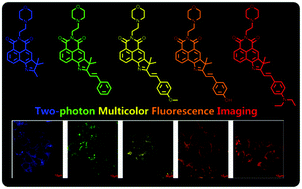Development of a unique family of two-photon full-color-tunable fluorescent materials for imaging in live subcellular organelles, cells, and tissues†
Abstract
Full-color fluorescence imaging, which utilizes multiple fluorescent imaging agents with emission covering the whole visible spectrum in the same specimen, is a powerful approach to study molecular processes in living systems. To achieve two-photon full-color bioimaging, two-photon full-color-tunable fluorescent materials (with emission from the blue to near-infrared region) are highly desirable. Herein, in this work, we outline the rational design, synthesis, optical property studies, and biological imaging studies of a unique family of two-photon full-color-tunable functional fluorescent materials. Based on the proposed “hybridization” strategy, we judiciously engineered the first family of two-photon full-color-tunable functional fluorescent materials (TPFC) and their lysosome-targetable derivatives (TPFC-Lyso). The novel TPFC dyes display two-photon full-color-tunable fluorescence emission from the blue to near-infrared region in solutions. By exploiting their unprecedented two-photon full-color-tunable properties, the new TPFC dyes were successfully applied for two-photon full-color imaging in living cells, and in particular, in living tissues at different penetration depths for the first time. In addition, as representative cases, we have described the first report of two-photon full-color fluorescence imaging in subcellular organelles, lysosomes, using the novel lysosome-targetable TPFC-Lyso dyes.

- This article is part of the themed collection: JMC B Editor’s choice web collection: ‘‘seeing the unseen updated: advances in bioimaging’’


 Please wait while we load your content...
Please wait while we load your content...